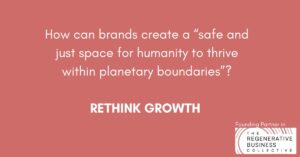2020 is the dawn of a new decade. Rachel Bevans explores the top ten themes driving brands and business from the last decade into the next one. Written for First 5000
Introduction
For many, 2019 has been in limbo.
There have been organisation shake-ups, projects stalling and brands standing up for what they believe in, but not a lot of forward motion.
In an environment of political instability and tightening of lending, we’ve experienced low consumer confidence and declining attitude to spending, low business confidence and declining media spending.
However there have been some significant milestones this year wrapping up this decade and forming a veritable platform for the next one.
Let’s take this chance to reset, take a deep breath to capture the key themes and set the brand wheels in motion for the years to come.
Ten Themes for 2020 and Beyond
- Creating Long-Term Value for All Stakeholders
- Purpose, Delivering Promises and Trust
- Employer Brand and Employee Experience
- Brand Alignment, Culture and Ecosystems
- Return to Investment in Long-Term Brand-Building
- Balancing Tech and Human Experiences
- Data Security, Privacy and Control
- Ethics in Marketing
- Seeking Competitive Advantage through Data and Innovation
- Wellbeing
Theme 1: Creating Long-Term Value for All Stakeholders
The realisation that people and profit go hand in hand, its not one or the other; and that organisations need to consider all stakeholders – customers, employees, shareholders, suppliers, partners and the community as a whole – in developing, aligning and driving their purpose and values, objectives and strategies to achieve long-term value.
Launching almost simultaneously with the final report for The Royal Commission into Banking Misconduct, in February 2019 the 4th Edition of the ASX Corporate Governance Principles and Recommendations came out in February 2019 with the guideline for values to be disclosed, against which an organisation’s officers and employees should be monitored.
Its states: “A listed entity should articulate and disclose its values. Values create a link between the entity’s purpose (why it exists) and its strategic goals (what it hopes to do) by expressing the standards and behaviours it expects from its directors, senior executives and employees to fulfil its purpose and meet its goals (how it will do it). In formulating its values, a listed entity should consider what behaviours are needed from its officers and employees to build long-term sustainable value for its security holders. This includes the need for the entity to preserve and protect its reputation and standing in the community and with key stakeholders, such as customers, employees, suppliers, creditors, law makers and regulators.”(Page 16)
In August this year, the US Business Roundtable – the body that issues Guidelines on Corporate Governance, and has since 1997 endorsed that corporations exist primarily to serve shareholders – redefined the purpose of a corporation signed by 181 CEOs to focus on generating long-term value for all stakeholders – customers, employees, suppliers, communities and shareholders, defining the brand promise and consistently delivering against it to build trust.
This is an outstanding platform to start the new decade.
Theme 2: Purpose, Delivering Promises and Trust
The first theme is the catalyst for any organisation that has not yet defined their higher purpose, to do so – defining the purpose for the organisation that drives long-term value for all stakeholders, defining the brand promise and consistently delivering against it to build trust.
Whilst purpose is here to stay, organisations and brands will continue to try to get this right – working out how it is communicated, if at all; recognising that savvy consumers don’t buy into woke washing so purpose needs to be driven across the whole organisation; including but not to be confused with CSR initiatives and standing up for issues.
Increasingly, employees and customers are expecting Organisations and CEOs to lead the way with positive change in conduct, social impact and even standing on political issues.
But this doesn’t mean a thing if the brand promise isn’t consistently delivered across every touch-point. As Edelman highlights in their 2019 Special Report “In Brands We Trust”, trust is gained by making a difference and delivering consistently.
The 2019 Edelman Trust Barometer indicates in Australia that 72% of respondents now agree that: “A company can take specific actions that both increase profits and improve the economic and social conditions in the communities where it operates”.
76% of respondents say that CEOs should take the lead on change rather than waiting for government to impose it – issues such as equal pay, prejudice and discrimination, training for the jobs of tomorrow, the environment, personal data, sexual harassment and fake news.
We have seen this year, more businesses and brands taking a stand on issues: with 2600 businesses signing up to “not business as usual” for action on climate change; 80 advertisers boycotting Alan Jones’ mistreatment of women; and many companies cancelling lunches for Melbourne Cup for its mistreatment of horses, or replacing it with donation drives for horse rescue and rehab. It feels like this will continue.
With a defined purpose and values that are acted upon, leaders as role models and a brand promise that is consistently delivered against across the business, brands have the ingredients build trust.
Theme 3: Employer Brand and Employee Experience
In Australia, the shift towards the most trusted relationship being “my employer” is well and truly embedded, having increased from 54% in 2016 to 77% in 2019, and significantly more than people trust NGOs (56%), business (52%), government (42%) and media (40%).
To earn and sustain trust, employers need to deliver against their promises to employees as well to customers and all stakeholders. There is now an expectation that employers will deliver customer-like experiences across the employee lifecycle that live up to the expectations set in the employer brand.
In order to do this, the employer, corporate and customer brands and experiences need to be aligned. It is no longer acceptable for companies to promise one thing to customers, another to employees, and another to shareholders, especially with the fluidity of brand relationships – customers become employees, employees are customers, employees are shareholders. More so, with social media fuelling brand transparency and the need to show one brand face.
Whilst the expression and emphasis of the brand may vary for employees, with the employee value proposition at the core, the employer brand has to be aligned.
Many organisations are still without an employer brand or defined employee experience, and many employer brands and experiences are not aligned and integrated with the rest of the business.
There is strong rationale for developing, aligning and integrating the employer brand and experience: competition increasing for attracting, retaining and engaging talent; research indicating that engaged and fulfilled talent are more productive; the need for employees to consistently deliver stakeholder experiences that live up to the brand promise; and the need for organisations to articulate their values and associated behaviours to drive culture “values in action”.
Theme 4: Brand Alignment, Culture and Ecosystems
With the changing, fluid and flexible nature of relationships between people, brands and organisations, and the need to leverage one identity across multiple audiences, products and services, media/touch-points and geographies in order to deliver seamless experiences and maximise investment, more organisations will seek brand and culture alignment over the next few years.
In “Fusion: How integrating brand and culture powers the world’s greatest organisations” launched in 2018, Denise Van Yohn states “despite the incredible value of an integrated and aligned brand and culture, most organisations not only separate them as if the two have nothing to do with another, but also go about building and cultivating them the wrong way”.
By aligning and activating people – customers, employees, stakeholders – and brands – customer, employer, corporate – around a common purpose, values and culture, organisations can move beyond siloed and matrix structures to agile, evolving ecosystems that facilitate delivering the personalised and compelling experiences that people expect, when, where and how they want it.
You can read more about ecosystem thinking for agile organisations and brand-culture alignment.
Theme 5: Return to Investment in Long-term Brand Building
Over the last decade, we have seen the rise of marketing as a science, with key research on “How brands grow” delivered by the Ehrenberg Bass Institute and Byron Sharp in 2010, Les Binet and Peter Field’s “Long and short of it” on advertising effectiveness in 2013 and Behaviours Economics with BETA (the government behavioural economics unit) established in 2015.
This means that now there is a good lot of evidence to support marketers in strategic direction for brands and investment.
One of the most critical pieces of research that was published in May this year was Les Binet and Peter Field’s B2B study that built upon their previous years of B2C research seeking to optimise effectiveness through understanding investment in long-term brand building versus short-term sales activation.
The findings highlighted that B2B was similar to B2C in that brands need to return to long-term brand building after an over-emphasis on short term sales activation, driven by digital.
Furthermore, B2B closely followed its B2C counterparts in ratios of long-term brand building to short term sales activation of 48% to 52% (B2B) compared to 60% to 40% (B2C).
Brand and Marketing now has a solid scientific springboard from which we can develop effective strategies and inspire creativity in the years to come.
Theme 6: Balancing Tech and Human Experiences
With advancements in technology, organisations and brands have been finding their way in applying technology, gathering and applying data to deliver seamless, secure and increasingly individualised experiences to their “customers” (be they consumers, employees, supply chain, partners, stakeholders).
I use “individualised” instead of “personalised” for the very reason of making the point that the focus on digital innovation has, in many cases, de-personalised or de-humanised the brand-customer relationship. From closing branches, replacement of cashiers with and call centres with chat bots and burying contact details; to remarketing that follows you around the web, SMS’s that know where you are and creepy emails that seem to know you too well. MarTech has exploded from 150 applications in 2011 to over 7,040 in 2019. And the potential is only going to increase with greater application of robots, artificial intelligence, machine learning and automation, and more effective application of data and analytics.
Of their CX 2030 report, Futurum Research principal analyst and founding partner, Daniel Newman states: “It is becoming increasingly clear there will be a rapid growth in the relationship between humans and machines over the next decade,”
“Companies will have to strike a delicate balance between providing highly empathic human-like experiences with the instantaneous results that consumers have come to expect. Technology will be the bridge as data, analytics, machine learning and AI will enable machines to deliver this balance in a more humanistic way that satisfies customers and delivers increased efficiencies to the enterprise.”
I wrote an article in August off the back of being inundated with content talking about the need for human centric organisations and more human experiences. This highlighted four key needs: the need to add qualitative insights to quantitative data; the need to develop experiences with your brand in hand; the need to treat the people who are designing experiences “more human”; the need to integrate technology in a way that is more human, and that doesn’t have to involve a human at all!
Theme 7: Data Security, Privacy & Control
In an environment where data is exploding and breaches are increasing, 74% of Australian consumers claim their confidence in a brand’s data security influences how they spend money with that brand: 36% say that they would spend more with a trusted and secure brand, 24% say they would stop spending with a brand they believe has insecure data practices and 14% say they would spend less with a brand they believe has insecure data practices. Yet levels of trust in data security are still low, particularly in industries that have experienced breaches – retail, financial services and travel.
In July of this year, the Consumer Data Right (CDR) came into play with the Banking Sector being the first industry to implement – coined “Open Banking” – to be followed by the energy and telecommunication sectors.
Its aim is “to provide greater choice and control for Australians over how their data is used and disclosed”, giving individual and business customers better access to their own data and ability to direct its secure transfer for trusted third parties.
Simultaneously, the ACCC Digital Platforms Inquiry report was released: identifying that consumers are not adequately informed about how their data is collected and used and have little control over the huge range of data collected; and recommending companies such as Google and Facebook make measures to rectify.
Knowing that consumer trust is imperative for brands to grow, data security, privacy and control will be a key driver for the next decade.
Theme 8: Ethics in Marketing
There are a number of areas where Ethics play in Marketing, two of these have key implications on the customer journey and customer experience, and the third on communications and transparency.
With the popularity of behavioural economics growing, in conjunction with AI and its capability to influence “next best action”, there will be a need for marketing to establish and monitor guidelines for what is ethical behaviour from the business and brand; when is a nudge too far?
We’ve seen the call for responsible lending from banks and responsible selling of mobile plans from telcos, shifting from mindless to mindful acquisition and increasing lifetime value (“trade up/broaden brand franchise”), ensuring the customer can meet financial commitments prior to making the sale.
Whilst there are commercial objectives to any marketing plan, with strategies to increase frequency of purchase, quantity purchased, trade up and broaden the brand franchise, the question has to be asked “is this profit for the good of people and planet?”
Another area is that of virtual reality, robots and digital creations with real-life human characteristics. An episode of Gruen aired in October discussed the digital character in #TeamGalaxy (Samsung’s latest campaign) and the need for brands to be pro-actively transparent in telling consumers that this character is digital, not real. Interesting times ahead!
Theme 9: Seeking Competitive Advantage through Data and Innovation
As the saying goes “what gets measured, gets managed”. With the amount of data that some organisations “measure” exploding, I can see this shifting to “what gets managed, gets measured”. That is, organisations will work out what data they need to collect, for what purpose and how to collect it, analyse it and report it so that it is actionable, rather than wasting excess resources collecting data that does not get used and reports that sit in a bottom drawer. Data effectiveness, so to speak.
Taking an ecosystem thinking approach to data will enable the inter-relationships to be identified, using the data to align people, brands and experiences across the organisation and customers’, employees’ and stakeholders’ ecosystems, thus presenting one brand face. Powerful leverage for a cluttered and dispersed market.
Organisations will be seeking competitive advantage in collecting and analysing data for innovation in products, services, experiences and new business opportunities.
With the CDR in July giving individuals greater control over their data to compare offers, it opens up traditional markets for increased competition and innovation. Open Banking has commenced with Energy and Telcos to come next.
Once organisations have worked through the data security and privacy issues and needs of their stakeholders, sharing data for mutual benefit (of the organisations and stakeholders) will fuel partnerships and collaborations, joint ventures, mergers and acquisitions, and the data economy as a whole.
We saw the acquisition of Fitbit by Google in November meet public concerns about how Google will manage this data, with both Fitbit and Google reassuring customers and the regulatory bodies that personal data would not be sold and that Fitbit health and wellness data would not be used for Google ads. We’ll see more of this to come.
Theme 10: Wellbeing
I’ve had a passion for wellbeing in its broadest sense for many years so have always monitored what’s happening closely. As such, it sits in the centre of The Healthy Brand Company’s brand alignment model along with purpose, values and idea, identity and culture. Anecdotally this year seems to have come to a tipping point where it has gone beyond innovators and early adopters and will soon be considered and threaded through everything we do.
One of the most significant moves was in May this year, when PM Jacinda Ahern launched NZ’s Wellbeing Budget. Who knows, with the ASX Corporate Guidelines’ shift to recognise a broader stakeholder audience and monitor values and behaviour, perhaps we could see more explicit guidelines for a Wellbeing Budget for Corporate Australia in the next revisions?
If we look at wellbeing in this broader context, it can be seen across industries and markets: from the rise in non-alcoholic drinks and vegetarian eating to government programmes to “Find your 30” and ban sugary drinks advertising in Singapore to improve physical wellbeing; from Facebook and Instagram’s removal of likes and Beyond the Blue’s small business owners campaign to positively impact mental wellbeing; to Westpac’s new brand promise of “Helping in the moments that matter” that goes beyond financial wellbeing to emotional wellbeing.
Wellbeing in the workplace has also been a focus this year, with the World Health Organisation officially redefining burnout as a syndrome “resulting from chronic workplace stress”, not to be confused with experiences in other areas of life. This has significant implications on employer brand, employee experience and culture.
Wellbeing is providing a path and inspiration for innovation, delivering “more human” experiences and creating long-term value for all stakeholders of an organisation.
I wish you and your business well for 2020 and Beyond.
Rachel Bevans is a strategic marketer and business director with over 25 years’ experience helping organisations become brand-driven, customer-centric and employee-engaged. Rachel founded The Healthy Brand Company in 2012 to unite her brand experience, passion for wellbeing and curiosity about what motivates people.
Image Source: Skypixel | Dreamstime.com




